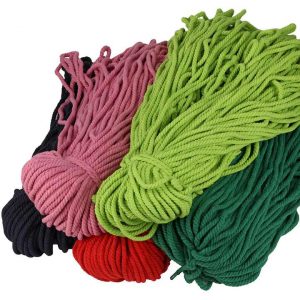1. Ring twister machine is mainly used for twisting PP/Polypropylene/HDPE/Polyethylene monofilament yarn for fishing net, rope, shade net, filter net, train or car safety net, agriculture twine, baler twine, binding twine etc.
Twisted Yarn Application:
It is suitable for pre-twisting and re-twisting of all kinds of PP/HDPE/PET/Nylon/Cotton twine and twisted ropes in different size.
Ring Twisting Machine
The plied yarn extracted from the bobbin passes through the yarn guide rod and traverse yarn guide, exiting from the yarn guide roller and winding onto the bobbin through the yarn guide hook and traveler. As the spindle rotates the bobbin, the yarn twists around the traveler on an annular ring.
Most bobbins on the bobbin creel are arranged horizontally on the spindle, with the plied yarn pulled from the side to rotate the bobbin and unwind it. Single yarn bobbin feeding in the doubling and twisting machine is optimized to reduce breakage by tightly sleeving tapered bobbins onto insert spindles, facilitating merging at the feeding creel. This machine eliminates the need for doubling processes and is generally suitable for double-stranded yarns with low spinning quality requirements.
Yarn guide rollers, usually paired smooth round rollers, maintain uniform yarn delivery to the twisting area. Some machines employ multiple bottom rollers to handle high twisting tension and ensure uniform yarn feeding. Certain twisting machines feature self-stopping devices for broken ends, while others incorporate water tanks under the yarn guide rod for wet twist twisting, enhancing yarn strength and surface smoothness.
The winding forming mechanism resembles that of a ring spinning machine, with a ring plate moved up and down by a forming cam to wind the yarn into a conical cross-winding package. Double-sided bobbins are common for spinning thick strands or on multi-twisting machines, where the ring plate’s slow, continuous lifting and lowering process increase package density and capacity.
The main distinction between traditional fancy twisting machines and general twisting machines lies in their yarn feeding mechanisms, tailored to different fancy thread types.


